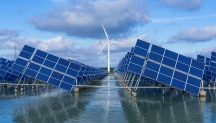

-
-
IRENA (2022), Renewable solutions in end-uses: Heat pump costs and markets, International Renewable Energy Agency, Abu Dhabi.
Copied
https://www.irena.org/-/media/Files/IRENA/Agency/Publication/2022/Nov/IRENA_Heat_Pumps_Costs_Markets_2022.pdf
Copied
Renewable solutions in end-uses: Heat pump costs and markets
Newsletter
If the world is to meet the goals of the Paris Agreement, policy makers must address the challenges of reducing energy use and increasing the share of renewable energy in end-use sectors. Globally, the buildings sector accounts for around three gigatonnes (Gt) of direct carbon dioxide (CO2) emissions per year, with electricity use and associated fossil fuel combustion for district heating raising that figure to 10 Gt of CO2 per year.
Electrically-driven heat pumps represent a solution that can increase the share of electrification in buildings while also dramatically improving the efficiency of energy use for space and water heating - the largest sources of energy use in temperate and cold climates. However, data on the costs and performance of heat pumps has not been widely available to policy makers, researchers or other stakeholders.
See the visual story: Solutions for Decarbonising Heating in Buildings
This report seeks to remedy that knowledge gap and support better informed decisions concerning the role of heat pumps. It provides an overview of heat pump technologies and their applications; discusses building stock and the implications for the use of heat pumps in both new and old buildings; examines recent market developments and the acceleration in heat pump deployment – particularly in Europe; and offers a detailed review of cost and performance trends for heat pumps by technology, system size and - in some cases - dwelling type.




